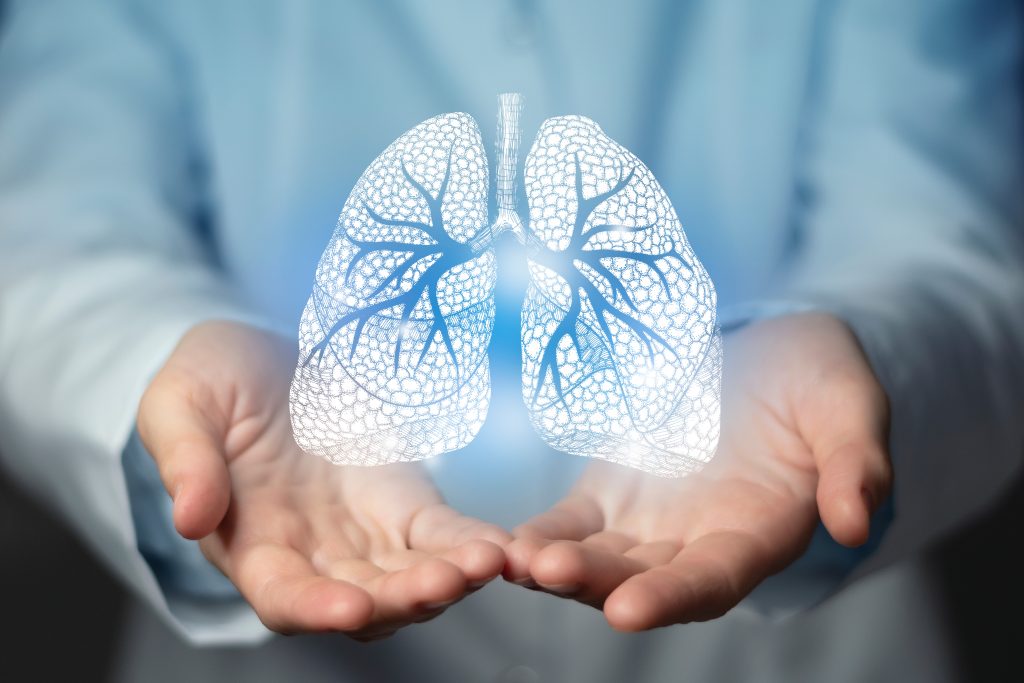In my last post on respiration, I introduced a very important chemical reaction which happens inside nearly every one of our cells. The reaction is called respiration. Respiration is often confused with breathing. It is not breathing, but breathing is necessary for respiration. However, so is digestion and circulation.
We spent a bit of time talking about how the reactants of respiration, glucose and oxygen, get to our cells and how the (waste) products, water and carbon dioxide, are carried away from our cells. The transport system which does all of this is our circulatory system. It is our blood which transports it all inside veins, capillaries and arteries. We finished up introducing the thing which pumps the blood around the body, the heart.
WHY WE SHOULD TAKE FLAT EARTHERS SERIOUSLY
The heart
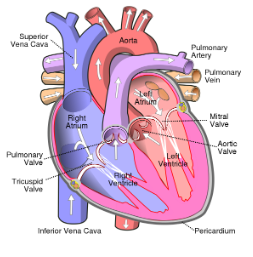
The heart is actually two pumps in one. One pumps blood to the lungs to get the oxygen (and release carbon dioxide) and the second pumps blood around the rest of the body to deliver the oxygen (and collect the carbon dioxide). This means the second pump would pump more strongly than the first as the blood needs to flow a longer way.
In the diagram on the right we see the heart. As you can see there are halves, one is more blue and the other is more pink. In reality the heart is not blue at all and neither is the blood at any point, but it is a colour code for the diagram. Blue means the blood has very little oxygen in it and pink (or red) means it has a lot of oxygen in it.
The two halves are the two pumps I was talking about earlier on. They are called atriums. Notice that the right atrium is actually on the left and the left is on the right? Why is that? It is because if we were doing an operation on someone’s heart, they would be lying on their back facing us. Their left would be on our right and vice versa.
Circulatory System
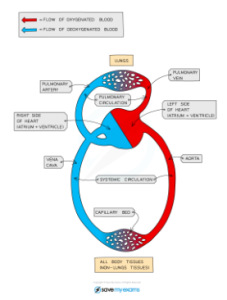
If you use the diagram of the circulatory system on the left with the diagram above we can see where the blood goes a little more easily. The right atrium pumps blood to the lungs via the pulmonary artery. Here is where it can collect oxygen and drop off carbon dioxide. Once it has done that it flows back into the pulmonary vein in the left atrium. Notice before it gets into the lungs the diagram shows the blood as blue to show a lack of oxygen in the blood and after the blood is red to show it now has a lot of oxygen in the blood. The left atrium now pumps the oxygenated blood around the rest of the body. The blood then flows back, now depleted of oxygen, into the vena cava in the right ventricle ready to repeat the cycle.
The lungs
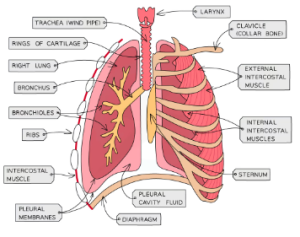
When the blood gets to the lungs to collect oxygen, how are the lungs suited to help with this process? We know that when we breathe in our lungs fill with air, but what else? What are we doing when we breathe in? How do we pull the air from the outside into our lungs?
Breathing is an interesting action. We mostly do it automatically when we’re concentrating on some other activity and even when we’re sleeping. However we can deliberately breathe as well. Most actions are either one or the other.
How does it work?
Whether we breathe deliberately or automatically, what we are doing is contracting our diaphragm which pulls down and forces our lungs to increase in size. As the lungs expand more air is drawn in to fill the space. Intercostal muscles also work to help expand our rib cage to help. The air flows into our nose or mouth and then down our trachea.
Half goes to the right and half to the left down bronchi (one bronchus, two bronchi). Then the bronchi split up into smaller tubes called bronchioles. The tubes keep splitting up like trunks, branches, sticks and twigs of a tree, until they reach very very tiny little air sacs called alveoli. Because the tubes split up so many times, one breath can reach many many alveoli and at this point the oxygen in the air is able to get into the blood by a process called diffusion. Basically, there is a higher concentration on one side than the other, so oxygen flows into the blood from the breathed in air.
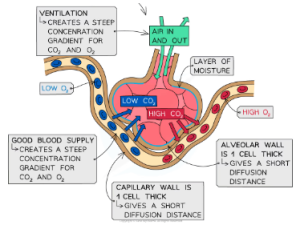
I could talk further about how digestion works to get the glucose into the body and what else the blood does and some of the other adaptations of the breathing system, confusingly called the respiratory system, as it is all of course connected, but I’ll leave it there for this 2 part series. I hope it helped clear up a few things and I shall look forward to writing the next post soon!
5 REASONS WHY GOOD STUDY SKILLS ARE IMPORTANT
A bit about the author, Paul H:
 Paul is a qualified and experienced Physics, Maths, and Science teacher, now working as a full-time tutor, providing online tuition using a variety of hi-tech resources to provide engaging and interesting lessons. He covers Physics, Chemistry, Biology, and Science from Prep and Key Stage 3 through to GCSE and IGCSE. He also teaches Physics, Maths, and Chemistry to A-Level across all the major Exam Boards.
Paul is a qualified and experienced Physics, Maths, and Science teacher, now working as a full-time tutor, providing online tuition using a variety of hi-tech resources to provide engaging and interesting lessons. He covers Physics, Chemistry, Biology, and Science from Prep and Key Stage 3 through to GCSE and IGCSE. He also teaches Physics, Maths, and Chemistry to A-Level across all the major Exam Boards.

